Unprompted Generosities: Being a guest on the Baja Divide
Originally posted on January 29, 2018 at 1:36 amWords by Emma Rehm, photos by Mike Q Roth
Since I finished riding the Baja Divide — 1400 miles of dirt and sand from San Diego, CA to La Paz, Baja California Sur — I’ve been waiting for its lessons to reveal themselves to me. Some are obvious: Don’t be in a hurry. See what unfolds instead of dreading or hoping things will shake out in some particular way. Sand isn’t all that bad if somebody’s ridden on it before you get there. But the lessons I seek are more elusive: what am I doing here? And why is everybody so nice to us?
A fellow Divide rider described Baja as the place where white people take their expensive toys to play. We met so many people who’d brought out their motorcycles and RAZRs and ATVs and bikes to come and “explore” Baja. We are not excluded from that group. The idea stuck in my thoughts for a thousand miles on the bike, and stayed with me after I got home. I started to wonder who we are to think of ourselves as explorers, when really we are guests.

And truly, we were treated like guests. Folks wished us well at every turn — the owner of a grocery store in Benito Juarez threw in a few extra limes when he rang us up, and came outside to clarify directions on the route for us. He told us that he’d seen a number of cyclists miss the turn heading down the steep hill, and wanted to make sure we didn’t have to climb any more than was necessary.
On a rest day in Mulegé, we wandered into a second-hand shop, and before I’d even had a chance to scan one shelf, an old man in the back calls out “I love foreigners!” in Spanish. Ok! I knew there was a reason I came in here! “We’re brother and sister, you know. God is my father, and God is your father, so we are brother and sister.” We have a funny conversation about faith, about peoples’ need to see something in order to believe in it, about human connection. He asks why we travel by bicycle. “That’s a good question!” I say, as he chuckles in the most grandfatherly way, “maybe it’s so we can find people like you.” He smiles and tells me that life is so simple. All we have to do is help each other out: “if everyone helps each other, nobody will need anything!” My eyes get misty.
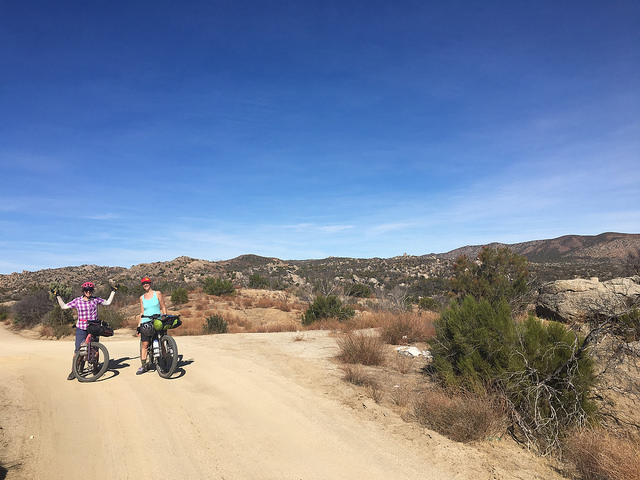
Every bike tour story I’ve ever read or heard involves some sweetness, some kind offer, some unprompted generosity. Is it just that humans are kind? Is it the apparent vulnerability of bike travel, the slower pace, the increased chances for one-on-one human interaction as compared to car travel?
As we rode across the salt flats, Sergio and Fabian leaned out the window of their pickup truck and gave us sweet perfect fresh oranges, for no other reason beyond the fact that they had oranges, and we were traveling slow enough to talk to.
Everywhere we went, drivers stopped to make sure we knew that it gets cold at night, and that we had enough clothes (“¡Hay frio en la noche!” accompanied by the universal symbol of coldness: hugging yourself and shivering). When I asked a woman if it we could camp on her property, she looked at our gear, gave me a concerned look, and pointed across the way. She felt that my chosen spot would be too cold, and directed us to set up camp under the trees instead.

Is the unprompted generosity due to our whiteness? White people tend to get a warm reception wherever we go, despite (and/or because of) a history of colonialism and genocide. Just as indigenous culture is erased in the US (American kids in public schools grow up believing that there are no more “Indians” and don’t learn that indigenous communities exist in the present), it is erased in Baja, at least for white audiences. Despite reading a lot about the history of Baja California before traveling, I didn’t realize that there are active indigenous communities in northern Baja (Pai-Pai, Kumeyaay, Cucapá, and Kiliwa — here’s an article about contemporary indigenous life). Everything I’d read framed the history like this: Indigenous people all died after contact with the Spanish, but you can still see some cave paintings! An interpretive sign at one of the missions we visited noted that it closed in 1818 “due to the decline of the Indian population” without naming the people (in this particular case, the Cochimí) or what happened (diseases brought from Europe killed almost the entire population, and some people assimilated). One lesson here is the lingering effects of an American education, and the need to re-examine my research methods.
Mountain bikers know that access to and ownership of land is always political. In the last year especially, the level of political engagement within the mountain biking community has increased exponentially around land protection and access to public land. But it’s also important to recognize how these lands became what we now call public, and to learn whose land we’re riding our bikes on. One tool for learning the traditional names and locations of indigenous people and why territory acknowledgment is important is https://native-land.ca. I’ve mentioned the nations in the north; the central and southern parts of the peninsula were home to the Cochimí, Monqui, Pericú, and Guaycura before contact with the Spanish.
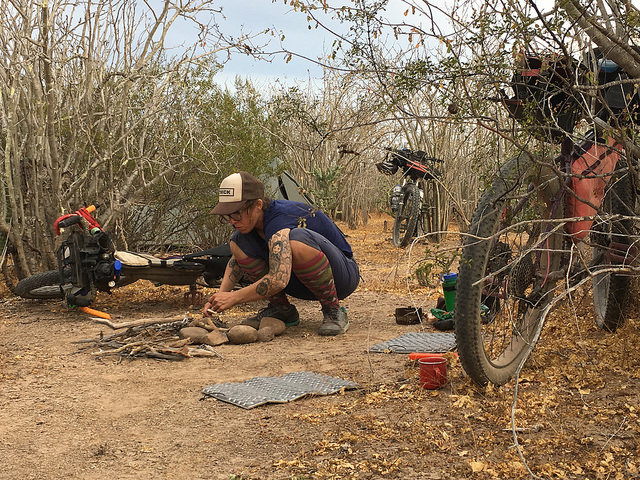
In one small community, burning daylight and exhausted from a hard day of riding in unseasonably hot weather, opening and closing a bunch of barbed wire gates, and a surprise encounter with two soldiers with huge guns (“Are you carrying anything illegal? Anything … herbal?” he asked, with a pointed look. I burst out laughing, and he said “Ok, we won’t search your bags. Go on.”), we stopped at a store only to find it closed. The locals drinking on the porch gave us directions to a place where we could get food. We rode on a little bit and paused to confer — wait, did he say up two blocks and then left, or left and then up two blocks? One of the locals hopped in his truck, said “follow me!” and led us directly to someone’s house, where a woman opened up the kitchen built on the side and asked us what we wanted her to cook.
We even got to eat homemade Christmas cookies! We stayed one night in a small town, where we ate dinner and watched a dance contest on tv with the family who owned the cabaña we rented. Celia gave us leftover birthday cake for dessert, and in the morning, gave me a stack of buñuelos made by her aunt. We conspired to keep it a secret so I could surprise my fellow travelers on Nochebuena.
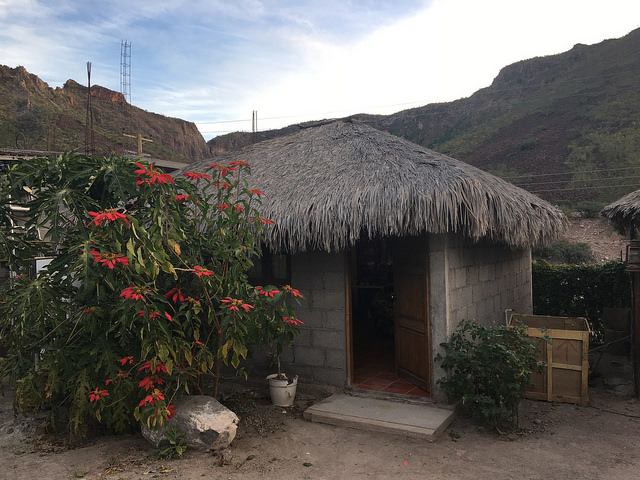
To engage with this remarkable hospitality, my hope is that I am a good guest, deserving of my welcome. I don’t want to be a consumer of culture; it’s not mine for the taking. But I don’t believe in the concept of an impartial observer, either: my very existence in a place changes it. So the question is: in what way am I changing the place? What am I bringing to the table? What do I have to offer? Especially when I have so much, and others have so little.
I can tease an abuelo in Spanish, and I can take the teasing that comes back, too. I can be aware of the resources I am consuming, of the help I am taking, of the challenges I am presenting. This is what I’m doing here: I am collecting stories to tell to my fellow Americans — stories that humanize, that make real, that illustrate the unreasonable generosities we experienced. I am also contemplating how I’ll carry this generosity forward, who I will direct it toward.
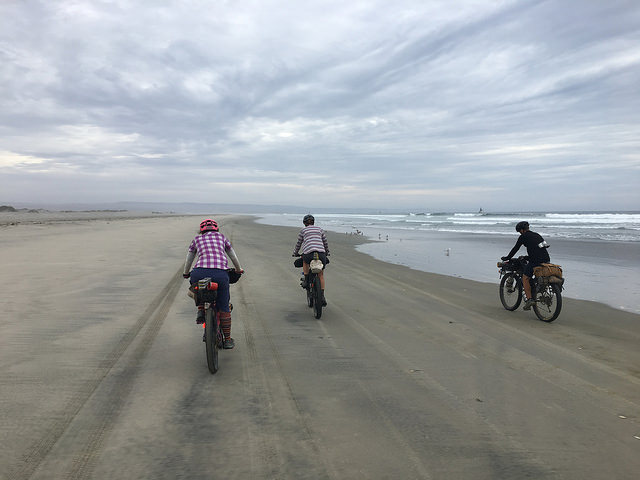
One of my favorite parts of being a guest is writing thank-you notes once I’m home. This is complicated by the fact that mail service ranges from spotty to nonexistent in a lot of Baja. So if anybody’s getting ready to ride the Divide and wants to hand-deliver some mail by bike, get in touch: there are some real sweethearts I want you to meet!
Since I’ve been home, people sometimes ask if anything sketchy went down while we were in Mexico. These are generally the same people who asked “aren’t you scared?” before we left. I’ve taken to responding dramatically, “Well, this one time, a truck slow-rolled to a stop next to us, and…” (here, I pause dramatically) “… the driver offered us beer and wished us good luck!”
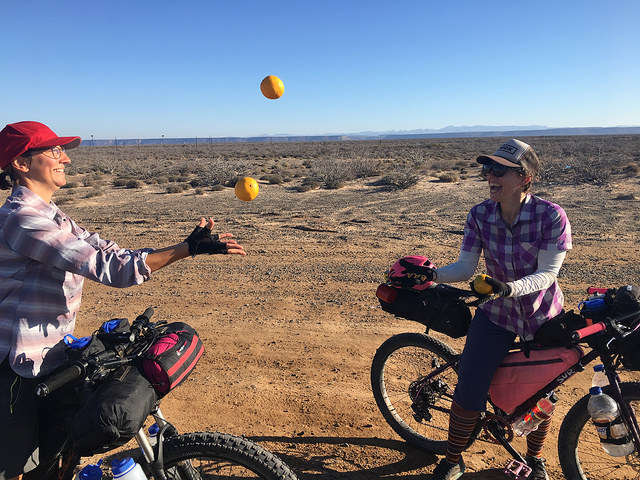
About the Author: Emma H. Rehm is a rider and writer who spends most of her time in western and central Pennsylvania, the traditional and unceded land of the Susquehannock, Potawatomi, and Osage nations and the Haudenosaunee Confederacy. You can find her on Instagram @the.emmahazel and read her stories at https://ridingthatbike.tumblr.com/